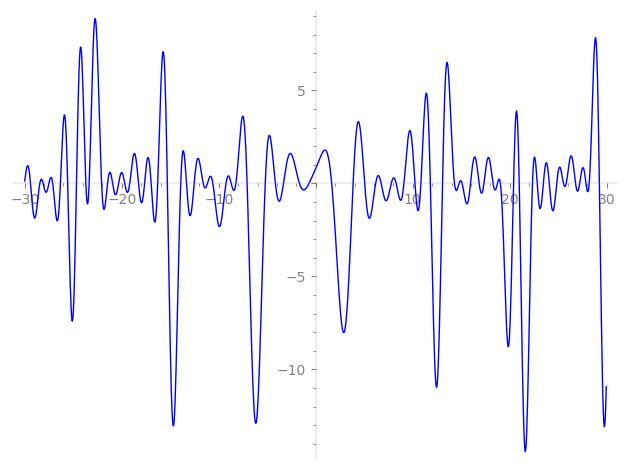| L(s) = 1 | + (−1.29 − 2.24i)2-s + (−2.34 + 4.06i)4-s + (−1.14 − 1.97i)5-s + (2.45 − 0.989i)7-s + 6.97·8-s + (−2.95 + 5.11i)10-s + (1.47 − 2.56i)11-s + 4.26·13-s + (−5.39 − 4.21i)14-s + (−4.32 − 7.49i)16-s + (0.764 − 1.32i)17-s + (−3.69 − 6.39i)19-s + 10.7·20-s − 7.64·22-s + (3.07 + 5.32i)23-s + ⋯ |
| L(s) = 1 | + (−0.914 − 1.58i)2-s + (−1.17 + 2.03i)4-s + (−0.510 − 0.884i)5-s + (0.927 − 0.374i)7-s + 2.46·8-s + (−0.934 + 1.61i)10-s + (0.445 − 0.771i)11-s + 1.18·13-s + (−1.44 − 1.12i)14-s + (−1.08 − 1.87i)16-s + (0.185 − 0.321i)17-s + (−0.846 − 1.46i)19-s + 2.39·20-s − 1.63·22-s + (0.641 + 1.11i)23-s + ⋯ |
Λ(s)=(=(567s/2ΓC(s)L(s)(−0.979−0.202i)Λ(2−s)
Λ(s)=(=(567s/2ΓC(s+1/2)L(s)(−0.979−0.202i)Λ(1−s)
| Degree: |
2 |
| Conductor: |
567
= 34⋅7
|
| Sign: |
−0.979−0.202i
|
| Analytic conductor: |
4.52751 |
| Root analytic conductor: |
2.12779 |
| Motivic weight: |
1 |
| Rational: |
no |
| Arithmetic: |
yes |
| Character: |
χ567(487,⋅)
|
| Primitive: |
yes
|
| Self-dual: |
no
|
| Analytic rank: |
0
|
| Selberg data: |
(2, 567, ( :1/2), −0.979−0.202i)
|
Particular Values
| L(1) |
≈ |
0.0811394+0.794087i |
| L(21) |
≈ |
0.0811394+0.794087i |
| L(23) |
|
not available |
| L(1) |
|
not available |
L(s)=p∏Fp(p−s)−1 | p | Fp(T) |
|---|
| bad | 3 | 1 |
| 7 | 1+(−2.45+0.989i)T |
| good | 2 | 1+(1.29+2.24i)T+(−1+1.73i)T2 |
| 5 | 1+(1.14+1.97i)T+(−2.5+4.33i)T2 |
| 11 | 1+(−1.47+2.56i)T+(−5.5−9.52i)T2 |
| 13 | 1−4.26T+13T2 |
| 17 | 1+(−0.764+1.32i)T+(−8.5−14.7i)T2 |
| 19 | 1+(3.69+6.39i)T+(−9.5+16.4i)T2 |
| 23 | 1+(−3.07−5.32i)T+(−11.5+19.9i)T2 |
| 29 | 1+2.34T+29T2 |
| 31 | 1+(3.11−5.38i)T+(−15.5−26.8i)T2 |
| 37 | 1+(3.58+6.21i)T+(−18.5+32.0i)T2 |
| 41 | 1+7.89T+41T2 |
| 43 | 1−0.834T+43T2 |
| 47 | 1+(2.91+5.04i)T+(−23.5+40.7i)T2 |
| 53 | 1+(3.71−6.44i)T+(−26.5−45.8i)T2 |
| 59 | 1+(−2.31+4.00i)T+(−29.5−51.0i)T2 |
| 61 | 1+(−3.56−6.17i)T+(−30.5+52.8i)T2 |
| 67 | 1+(−1.66+2.87i)T+(−33.5−58.0i)T2 |
| 71 | 1−0.160T+71T2 |
| 73 | 1+(−0.190+0.329i)T+(−36.5−63.2i)T2 |
| 79 | 1+(−3.97−6.88i)T+(−39.5+68.4i)T2 |
| 83 | 1−4.29T+83T2 |
| 89 | 1+(−3.02−5.24i)T+(−44.5+77.0i)T2 |
| 97 | 1+1.32T+97T2 |
| show more | |
| show less | |
L(s)=p∏ j=1∏2(1−αj,pp−s)−1
Imaginary part of the first few zeros on the critical line
−10.60326633351614945220489364695, −9.247690744055262978854226996565, −8.713739201457723557986293555397, −8.230969955003856152059665021997, −7.07350210043332575035330976142, −5.20442330910704329902035238741, −4.15690507806590389127221330874, −3.32299023482943864578219838519, −1.67962559926462854111824903477, −0.69491116027861631629233463245,
1.64686653680827616898102988237, 3.85437564566033959001911822084, 5.04377372336568548520017354712, 6.17763829320418665201814393965, 6.74796466564479736261787165812, 7.78905575898734090438604795743, 8.289772088724781405544398818394, 9.094326454606083495736008949070, 10.23152877811182990524707837597, 10.84331966763799627996189629843

